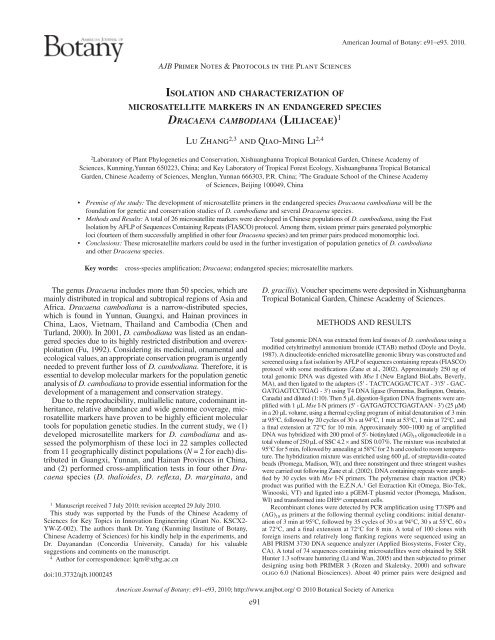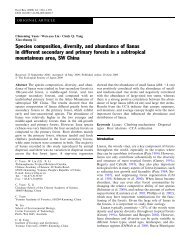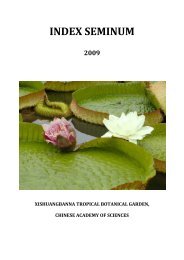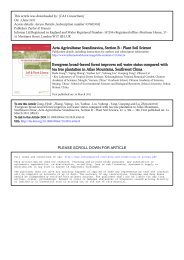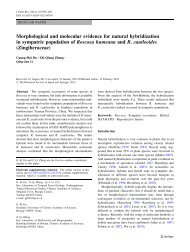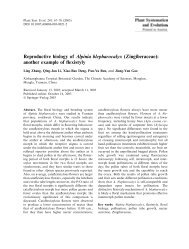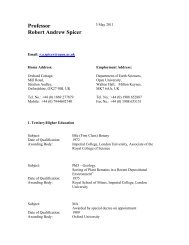Lu Zhang 2,3 and Qiao-Ming Li 2,4
Lu Zhang 2,3 and Qiao-Ming Li 2,4
Lu Zhang 2,3 and Qiao-Ming Li 2,4
Create successful ePaper yourself
Turn your PDF publications into a flip-book with our unique Google optimized e-Paper software.
American Journal of Botany: e91–e93. 2010.<br />
AJB Primer Notes & Protocols in the Plant Sciences<br />
I SOLATION AND CHARACTERIZATION OF<br />
MICROSATELLITE MARKERS IN AN ENDANGERED SPECIES<br />
DRACAENA CAMBODIANA (LILIACEAE) 1<br />
<strong>Lu</strong> <strong>Zhang</strong><br />
2,3<br />
<strong>and</strong> <strong>Qiao</strong>-<strong>Ming</strong> <strong>Li</strong> 2,4<br />
2<br />
Laboratory of Plant Phylogenetics <strong>and</strong> Conservation, Xishuangbanna Tropical Botanical Garden, Chinese Academy of<br />
Sciences, Kunming,Yunnan 650223, China; <strong>and</strong> Key Laboratory of Tropical Forest Ecology, Xishuangbanna Tropical Botanical<br />
Garden, Chinese Academy of Sciences, Menglun, Yunnan 666303, P.R. China; 3 The Graduate School of the Chinese Academy<br />
of Sciences, Beijing 100049, China<br />
• Premise of the study: The development of microsatellite primers in the endangered species Dracaena cambodiana will be the<br />
foundation for genetic <strong>and</strong> conservation studies of D. cambodiana <strong>and</strong> several Dracaena species.<br />
• Methods <strong>and</strong> Results: A total of 26 microsatellite markers were developed in Chinese populations of D. cambodiana , using the Fast<br />
Isolation by AFLP of Sequences Containing Repeats (FIASCO) protocol. Among them, sixteen primer pairs generated polymorphic<br />
loci (fourteen of them successfully amplified in other four Dracaena species) <strong>and</strong> ten primer pairs produced monomorphic loci.<br />
• Conclusions: These microsatellite markers could be used in the further investigation of population genetics of D. cambodiana<br />
<strong>and</strong> other Dracaena species.<br />
Key words:<br />
cross-species amplification; Dracaena ; endangered species; microsatellite markers.<br />
The genus Dracaena includes more than 50 species, which are<br />
mainly distributed in tropical <strong>and</strong> subtropical regions of Asia <strong>and</strong><br />
Africa. Dracaena cambodiana is a narrow-distributed species,<br />
which is found in Yunnan, Guangxi, <strong>and</strong> Hainan provinces in<br />
China, Laos, Vietnam, Thail<strong>and</strong> <strong>and</strong> Cambodia ( Chen <strong>and</strong><br />
Turl<strong>and</strong>, 2000 ). In 2001, D. cambodiana was listed as an endangered<br />
species due to its highly restricted distribution <strong>and</strong> overexploitation<br />
( Fu, 1992 ). Considering its medicinal, ornamental <strong>and</strong><br />
ecological values, an appropriate conservation program is urgently<br />
needed to prevent further loss of D. cambodiana . Therefore, it is<br />
essential to develop molecular markers for the population genetic<br />
analysis of D. cambodiana to provide essential information for the<br />
development of a management <strong>and</strong> conservation strategy.<br />
Due to the reproducibility, multiallelic nature, codominant inheritance,<br />
relative abundance <strong>and</strong> wide genome coverage, microsatellite<br />
markers have proven to be highly efficient molecular<br />
tools for population genetic studies. In the current study, we (1)<br />
developed microsatellite markers for D. cambodiana <strong>and</strong> assessed<br />
the polymorphism of these loci in 22 samples collected<br />
from 11 geographically distinct populations ( N = 2 for each) distributed<br />
in Guangxi, Yunnan, <strong>and</strong> Hainan Provinces in China,<br />
<strong>and</strong> (2) performed cross-amplification tests in four other Dracaena<br />
species ( D. thalioides , D. refl exa , D. marginata , <strong>and</strong><br />
1<br />
Manuscript received 7 July 2010; revision accepted 29 July 2010.<br />
This study was supported by the Funds of the Chinese Academy of<br />
Sciences for Key Topics in Innovation Engineering (Grant No. KSCX2-<br />
YW-Z-002). The authors thank Dr. Yang (Kunming Institute of Botany,<br />
Chinese Academy of Sciences) for his kindly help in the experiments, <strong>and</strong><br />
Dr. Dayan<strong>and</strong>an (Concordia University, Canada) for his valuable<br />
suggestions <strong>and</strong> comments on the manuscript.<br />
4<br />
Author for correspondence: lqm@xtbg.ac.cn<br />
doi:10.3732/ajb.1000245<br />
D. gracilis ). Voucher specimens were deposited in Xishuangbanna<br />
Tropical Botanical Garden, Chinese Academy of Sciences.<br />
METHODS AND RESULTS<br />
Total genomic DNA was extracted from leaf tissues of D. cambodiana using a<br />
modified cetyltrimethyl ammonium bromide (CTAB) method ( Doyle <strong>and</strong> Doyle,<br />
1987 ). A dinucleotide-enriched microsatellite genomic library was constructed <strong>and</strong><br />
screened using a fast isolation by AFLP of sequences containing repeats (FIASCO)<br />
protocol with some modifications ( Zane et al., 2002 ). Approximately 250 ng of<br />
total genomic DNA was digested with Mse I (New Engl<strong>and</strong> BioLabs, Beverly,<br />
MA), <strong>and</strong> then ligated to the adapters (5 ′ - TACTCAGGACTCAT - 3 ′ /5 ′ - GAC-<br />
GATGAGTCCTGAG - 3 ′ ) using T4 DNA ligase (Fermentas, Burlington, Ontario,<br />
Canada) <strong>and</strong> diluted (1:10). Then 5 μ L digestion-ligation DNA fragments were amplified<br />
with 1 μ L Mse I-N primers (5 ′ - GATGAGTCCTGAGTAAN - 3 ′ ) (25 μ M)<br />
in a 20 μ L volume, using a thermal cycling program of initial denaturation of 3 min<br />
at 95 ° C, followed by 20 cycles of 30 s at 94 ° C, 1 min at 53 ° C, 1 min at 72 ° C, <strong>and</strong><br />
a final extension at 72 ° C for 10 min. Approximately 500 – 1000 ng of amplified<br />
DNA was hybridized with 200 pmol of 5 ′ - biotinylated (AG) 15 oligonucleotide in a<br />
total volume of 250 μ L of SSC 4.2 × <strong>and</strong> SDS 0.07%. The mixture was incubated at<br />
95 ° C for 5 min, followed by annealing at 58 ° C for 2 h <strong>and</strong> cooled to room temperature.<br />
The hybridization mixture was enriched using 600 μ L of streptavidin-coated<br />
beads (Promega, Madison, WI), <strong>and</strong> three nonstringent <strong>and</strong> three stringent washes<br />
were carried out following Zane et al. (2002) . DNA containing repeats were amplified<br />
by 30 cycles with Mse I-N primers. The polymerase chain reaction (PCR)<br />
product was purified with the E.Z.N.A. 1 Gel Extraction Kit (Omega, Bio-Tek,<br />
Winooski, VT) <strong>and</strong> ligated into a pGEM-T plasmid vector (Promega, Madison,<br />
WI) <strong>and</strong> transformed into DH5 α competent cells.<br />
Recombinant clones were detected by PCR amplification using T7/SP6 <strong>and</strong><br />
(AG) 10 as primers at the following thermal cycling conditions: initial denaturation<br />
of 3 min at 95 ° C, followed by 35 cycles of 30 s at 94 ° C, 30 s at 55 ° C, 60 s<br />
at 72 ° C, <strong>and</strong> a final extension at 72 ° C for 8 min. A total of 100 clones with<br />
foreign inserts <strong>and</strong> relatively long flanking regions were sequenced using an<br />
ABI PRISM 3730 DNA sequence analyzer (Applied Biosystems, Foster City,<br />
CA). A total of 74 sequences containing microsatellites were obtained by SSR<br />
Hunter 1.3 software huntering ( <strong>Li</strong> <strong>and</strong> Wan, 2005 ) <strong>and</strong> then subjected to primer<br />
designing using both PRIMER 3 ( Rozen <strong>and</strong> Skaletsky, 2000 ) <strong>and</strong> software<br />
oligo 6.0 (National Biosciences). About 40 primer pairs were designed <strong>and</strong><br />
American Journal of Botany: e91–e93, 2010; http://www.amjbot.org/ © 2010 Botanical Society of America<br />
e91
e92 American Journal of Botany [Vol. 0<br />
Table 1. Characteristics of the 16 polymorphic <strong>and</strong> 10 monomorphic microsatellite markers developed in Dracaena cambodiana .<br />
Locus Primer sequence(5 ′ → 3 ′ ) Repeat motif T a( ° C) No. of cycles Allele size (bp) GenBank Accession No.<br />
DC003<br />
DC006<br />
DC128<br />
DC136<br />
DC138<br />
DC140<br />
DC317<br />
DC318<br />
DC435<br />
DC437<br />
DC448<br />
DC456<br />
DC460<br />
DC501<br />
DC516<br />
DC616<br />
DC121<br />
DC124<br />
DC305<br />
DC319<br />
DC402<br />
DC415<br />
DC450<br />
DC465<br />
DC522<br />
DC623<br />
F:AGAAAGGGAGGTGACAGG<br />
R:GTCAAAGAGCCCAAACAA<br />
F:GTTTCTAGTTCAAGAACCCAA<br />
R:TTCCTCCTCTTTCTCATCCT<br />
F:CCTGAGTAATGGGACTATA<br />
R:TGTGAGACCCAAATGCTA<br />
F:CAGGATCACAAGTGCTAT<br />
R:CCTGAGTAAGGAGTACAA<br />
F:GCAAGGGTTGATGATAGA<br />
R:TGAGAACAGCAATGATTAG<br />
F:AGCGTATTCAAAATGTCC<br />
R:TCTGTTGCTATCGTGATC<br />
F:TCGGTCTTAGCTTTCTCC<br />
R:AGTAAGGTTAGGGCTTGA<br />
F:GAGAATCAGGTTATGGTC<br />
R:GTAATCCCCAATTACTCG<br />
F:AACCCCTTACTTGTCCAC<br />
R:CCAACTTACCTTTTGCTAC<br />
F:TGGAGCTAAGAAGAATAGAA<br />
R:GTAAGGAGCAGGAGGTGT<br />
F:TAAGGGAGATCCAAGGAA<br />
R:AACCTCCAATTTGAAACC<br />
F:CGCTTTGCTTTGTGAATC<br />
R:CTCCAACTATGGCACCTC<br />
F:AACAACAGCAGCAACGAC<br />
R:GGCTTGGCTTCTGGGAAA<br />
F:CCCACTAACTCAAAGAAG<br />
R:AACACGAATGTGAAAAGG<br />
F:GGGGAATTTCCGTTGCTT<br />
R:CTGGACGTGAGTATTTGG<br />
F:TAGAAAGTTTGTAGCCAA<br />
R:GAGATTGTGAGCCATAAA<br />
F:AATAAGGGCAGAGGAGGA<br />
R:CGTGGGATTTGTACTTGC<br />
F:GCCCTGTATCTGCCACTT<br />
R:CACCTTCAACATGCACCC<br />
F:TTAGGGCTGGTTTGCTCA<br />
R:GTAAAACGGGCCGGAAGG<br />
F:ATTGTGGATTGGATGAAG<br />
R:GCTAGTACCAAACAGGAA<br />
F:GACTGGCTAAAGAAATGGA<br />
R:TGGGAGGTAGCTGAAAGA<br />
F:AAGACTGGGAGAAGAGCA<br />
R:TGAGTAAGAAATAAAACGGA<br />
F:GAGGCACATCGGCAAGTT<br />
R:CTTCTTCCATCTCCCACC<br />
F:TCCCATAAATGCTCCTCA<br />
R:TCAAGCTATGCATCCAAC<br />
F:GTAAGAAGAAAAGAGGAAGA<br />
R:AGGGAATCTGTCACTTGT<br />
F:TGGTTTGGATGCAGGGAG<br />
R:CGTGACACCACCAGAAGAA<br />
T a, annealing temperature.<br />
(AG) 10 ..(AG) 5 A(AG) 5 54 30 169 – 212 HM215604<br />
(AG) 16 54 30 188 – 200 HM215605<br />
(CT) 9 46 30 182 – 206 HM215606<br />
(GA) 10 50 35 222 – 231 HM215607<br />
(AG) 13 50 30 160 – 184 HM215608<br />
(TCA) 6 TG(GA) 9 48 35 140 – 158 HM215609<br />
(CT) 6 C 2AC 4 T(TC) 12 48 30 166 – 202 HM215610<br />
(AG) 12 50 30 152 – 170 HM215611<br />
(AG) 12 52 35 121 – 137 HM215612<br />
(GT) 8 (GA) 8 48 30 109 – 117 HM215613<br />
(TG) 5 A(GT) 8 (GA) 11 46 30 229 – 258 HM215614<br />
(TC) 18 ACT(CA) 11 60 30 315 – 342 HM215615<br />
(CT) 13 52 30 159 – 167 HM215616<br />
(GA) 23 48 30 187 – 213 HM215617<br />
(GA) 8 ..(AG) 23 54 40 165 – 195 HM215618<br />
(CT) 9 (CA) 9 50 30 172 – 184 HM215619<br />
(AAT) 5 ..(AG) 15 50 30 167 HM581792<br />
(TC) 10 54 35 184 HM581793<br />
(AG) 9 54 40 439 HM581794<br />
(CT) 6 ..(TC) 12 48 30 273 HM581795<br />
(GA) 7 GC(GA) 7 50 35 197 HM581796<br />
(GA) 5 ..(GA) 8 54 30 414 HM581797<br />
(AG) 8 ..(TG) 8 (GA) 6 56 40 358 HM581798<br />
(CT) 9 48 35 162 HM581799<br />
(GA) 20 52 40 146 HM581800<br />
(GA) 8 52 35 224 HM581801<br />
used for the subsequent test. These primers are all free of dimer <strong>and</strong> hairpin<br />
structure in 3 ′ -termini, the length of each primer was 18 – 20 bp, <strong>and</strong> the value of<br />
T m are ranged from 48 ° C to 60 ° C.<br />
The final SSR-PCR system used in screening was optimized by an orthogonal<br />
design experiment, <strong>and</strong> four levels of five factors (Mg 2+ , dNTP, Primer, Taq<br />
polymerase, <strong>and</strong> DNA template) have been tested separately in this system. The<br />
results demonstrated the reaction efficiency was affected by these factors.<br />
Based on the results, a stable, productive <strong>and</strong> reproducible PCR system was<br />
obtained: 20 μ L system containing 10 ng template DNA, 0.4 μ M of forward <strong>and</strong><br />
reverse primers, 2.5 mM of MgCl 2 , 0.2 mM of dNTPs, 2 μ L 10 × Taq buffer<br />
<strong>and</strong> 1.0 unit of Taq polymerase (Takara, Dalian, <strong>Li</strong>aoning, China). Cycling<br />
conditions were 94 ° C for 5 min followed by 30 – 40 cycles at 94 ° C for 30 s,<br />
46 ° C – 60 ° C for 30 s (number of cycles <strong>and</strong> annealing temperatures were locusspecific;<br />
see Table 1 ) , <strong>and</strong> 72 ° C for 1 min, with a final extension step of 8 min<br />
at 72 ° C. The PCR product was then separated on a 8% denaturing polyacrylamide<br />
gel <strong>and</strong> visualized by silver staining. A 25 bp DNA ladder (Promega, Madison,<br />
WI) was used as st<strong>and</strong>ard for scoring.<br />
A total of 26 of the 40 primers successfully amplified DNA fragments, with<br />
16 showing polymorphism <strong>and</strong> 10 showing monomorphism. Preliminary population<br />
genetics analyses for these polymorphic loci were performed using GENE-<br />
POP version 4.0 ( Rousset, 2008 ). The number of alleles per locus ( A ) was 6 to 14<br />
with an average of 9.188, the expected heterozygosity ( H E ) ranged from 0.668 to<br />
0.940 <strong>and</strong> the observed heterozygosity ( H O ) varied from 0.333 to 0.875 ( Table 2 )<br />
. Eight of the 16 polymorphic loci departed significantly from the Hardy-Weinberg<br />
equilibrium ( P < 0.01), which was due to excess of homozygosites. Analysis<br />
of errors using Micro-Checker version 2.2.3 ( van Oosterhout et al., 2004 )
October 2010] AJB Primer Notes & Protocols – Dracaena cambodiana microsatellites<br />
e93<br />
Table 2. Results of initial primer screening in 22 individuals of Dracaena<br />
cambodiana for 16 polymorphic loci. Number of alleles ( A ), observed<br />
heterozygosity ( H O ), expected heterozygosity ( H E ), fixation index (F)<br />
<strong>and</strong> P -values for the Hardy-Weinberg equilibrium (HWE) test are<br />
given for each marker.<br />
Locus A Ho H E F HWE<br />
DC003 7 0.632 0.859 0.275 0.020<br />
DC006 11 0.773 0.906 0.127 0.005*<br />
DC128 7 0.333 0.756 0.597 0.000*<br />
DC136 9 0.650 0.892 0.314 0.000*<br />
DC138 13 0.875 0.897 − 0.007 0.050<br />
DC140 14 0.632 0.935 0.390 0.000*<br />
DC317 13 0.750 0.899 0.144 0.053<br />
DC318 7 0.682 0.668 − 0.044 0.480<br />
DC435 8 0.727 0.889 0.163 0.272<br />
DC437 8 0.563 0.865 0.442 0.000*<br />
DC448 7 0.625 0.853 0.413 0.000*<br />
DC456 6 0.533 0.770 0.350 0.047<br />
DC460 6 0.632 0.817 0.298 0.001*<br />
DC501 11 0.364 0.940 0.795 0.000*<br />
DC516 14 0.773 0.918 0.138 0.047<br />
DC616 6 0.688 0.806 0.404 0.177<br />
*Indicates the observed heterozygosity is departed significantly from<br />
the expected heterozygosity under Hardy-Weinberg equilibrium ( P < 0.01).<br />
Voucher specimens of 11 Dracaena cambodiana natural populations:<br />
DCJC1568; DCPX1569; DCDF1570; DCSY1571; DCJG1572; DCMY1573;<br />
DCZK1574; DCML1575; DCXBL1576; DCMX1577; DCYW1578 were<br />
all deposited in Xishuangbanna Tropical Botanical Garden, Chinese Academy<br />
of Sciences.<br />
suggested that these loci are likely to contain null alleles. No significant linkage<br />
disequilibrium was detected between locus pairs except for locus pair DC136 <strong>and</strong><br />
DC140, DC435 <strong>and</strong> DC501, DC435 <strong>and</strong> DC516, DC003 <strong>and</strong> DC616, DC448 <strong>and</strong><br />
DC616 ( P < 0.01). These 16 loci further investigated for cross-species amplification<br />
in other four Dracaena (D. thalioides , D. reflexa , D. marginata , D. gracilis )<br />
species using five individuals for each species. In this test, 14 loci successfully<br />
amplified products, <strong>and</strong> 10 primer pairs among them showed polymorphism in at<br />
least one of these four Dracaena species ( Table 3 ) .<br />
CONCLUSIONS<br />
A total of 26 primer pairs in D. cambodiana could be used to<br />
assess the genetic diversity <strong>and</strong> genetic structure of Dracaena<br />
species for further evaluation <strong>and</strong> research.<br />
LITERATURE CITED<br />
Chen , S. C. , <strong>and</strong> N. J. Turl<strong>and</strong> . 2000 . Flora of China 24 : 215 – 217 .<br />
Science Press, Beijing, China.<br />
Table 3. Cross-amplification of 16 polymorphic microsatellite loci<br />
across other four Dracaena species.<br />
Locus<br />
Dracaena<br />
thalioides<br />
( N = 5)<br />
Dracaena<br />
refl exa<br />
( N = 5)<br />
Dracaena<br />
marginata<br />
( N = 5)<br />
Dracaena<br />
gracilis<br />
( N = 5)<br />
DC003 127, 137 141 143 131, 143<br />
DC006 198 P(3)/196-206 204 204, 206<br />
DC128 N N 184 184<br />
DC136 190 208, 210 204, 206 208, 210<br />
DC138 N 140, 148 146 N<br />
DC140 N N N N<br />
DC317 N 106, 108 109, 111 104, 106<br />
DC318 N 176 176 176<br />
DC435 P(6)/110-128 110 118 104, 106<br />
DC437 N N N N<br />
DC448 N N 196 196<br />
DC456 320, 328 330, 332 332 N<br />
DC460 P(3)/141-204 141 137, 141 161, 164<br />
DC501 P(4)/166-191 161, 187 166, 180 168, 174<br />
DC516 160 162, 164 144, 146 154, 156<br />
DC616 138 156 158 158<br />
n, Sample size; N, no amplification; P, polymorphic amplification,<br />
numbers in parentheses showed the number of alleles <strong>and</strong> the range of<br />
product size; Voucher specimen of four Dracaena species: DT1026 ( D.<br />
thalioides ); DR1027 ( D. refl exa ); DM1028 ( D. marginata ); DG1029 ( D.<br />
gracilis ) were all deposited in Xishuangbanna Tropical Botanical Garden,<br />
Chinese Academy of Sciences.<br />
Doyle , J. J. , <strong>and</strong> J. L. Doyle . 1987 . A rapid DNA isolation procedure<br />
for small quantities of fresh leaf tissue. Phytochemistry 19 : 11 – 15 .<br />
Fu , L. G. 1992 . Red book of Chinese plant — rare <strong>and</strong> endangered species<br />
(Vol. 1). Science Press, Beijing, China.<br />
<strong>Li</strong> , Q. , <strong>and</strong> J. M. Wan . 2005 . SSRHunter: Development of a local searching<br />
software for SSR sites. Hereditas 27 : 808 – 810 .<br />
Rousset , F. 2008 . GenePop ′ 007: a complete re-implementation of the<br />
GenePop software for Windows <strong>and</strong> <strong>Li</strong>nux. Molecular Ecology<br />
Resources 8 : 103 – 106 .<br />
Rozen , S. , <strong>and</strong> H. J. Skaletsky . 2000 . Primer 3 on the WWW for<br />
general users <strong>and</strong> for biologist programmers. In S. Krawetz <strong>and</strong> S.<br />
Misener [eds.], Bioinformatics Methods <strong>and</strong> Protocols: Methods<br />
in Molecular Biology, 365 – 386. Humana Press, Totowa, New<br />
Jersey.<br />
Van Oosterhout , C. , W. F. Hutchinson , D. P. M. Wills , <strong>and</strong> P.<br />
Shipley . 2004 . Micro-checker: software for identifying <strong>and</strong> correcting<br />
genotyping errors in microsatellite data. Molecular Ecology Notes<br />
4 : 535 – 538 .<br />
Zane , L. , L. Bargelloni , <strong>and</strong> T. Patarnellon . 2002 . Strategies for<br />
microsatellite isolation: a review. Molecular Ecology 11 : 1 – 16 .


